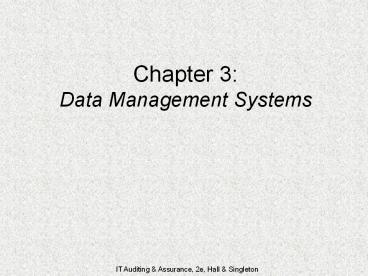Chapter 3: Data Management Systems - PowerPoint PPT Presentation
1 / 23
Title: Chapter 3: Data Management Systems
1
Chapter 3Data Management Systems
2
DATA-FLAT FILES
- e.g., Figure 3.1 p.94
- Disadvantages
- Data storage
- Data updating
- Currency of information
- Task-data dependency (limited access)
- Data integration (limited inclusion)
- Do not use accounting data to support decisions
- Manipulate existing data to suit unique needs
- Obtain additional private sets of data, incurring
costs and operational problems
3
DATA-DATABASE
- e.g., Figure 3.2 p.96
- How database approach eliminates the five
disadvantages of flat files - Data storage
- Data updates
- Currency of information
- Task-data dependency (limited access)
- Data integration (limited inclusion)
4
CENTRALIZED DATABASE SYSTEM
- Figure 3.3 p.98Database Environment
- DBMS
- Users
- Database administrator
- Physical database
5
DBMS
- Typical features
- Program development
- Backup and recovery
- Database usage reporting
- Database access
6
DBMS
- Data definition language (DDL)
- Views
- Figure 3.4 p.99
- Internal / physical view
- Conceptual / logical view
- External / user view
7
USERS
- Formal access application interfaces
- Data manipulation language (DML)
- DBMS operations 7 steps Figure 3.4
- Informal access query
- Define query
- SQL
- is industry de facto standard query language
- Select, from, where commands
- Review Figure 3.5 p.101 SQL process
- QBE
8
DBA
- DBA
- Manages the database resources Table 3.1
p.102 - Database planning
- Database design
- Database implementation
- Database operations maintenance
- Change growth
- Data dictionary
- Interactions Figure 3-6, p.103
9
PHYSICAL DATABASE
- Data structures
- Data organization
- Sequential
- Random
- Data access methods
- Data hierarchy
- Attribute/field
- Record
- Associations
- File
- Database
- Enterprise database
10
DATABASE MODELS
- Hierarchical
- Network
- Relational
- Object-oriented
11
RELATIONAL MODEL - TERMS
- TABLE file
- COLUMN field
- ROW record
12
RULE 1
- Entries in the table cells MUST be single-valued
- Cannot be null
- Cannot be multi-values
- Example
13
RULE 2
- Consistency applies to columnar values same
class
14
RULE 3
- Column names are distinct
- Example cost for sales price and unit cost
columns
15
RULE 4
- Each row contains distinctively different data
from all other rows - Requires use of key field(s)
16
RELATIONAL MODEL
- Figure 3-13, p. 112
17
DATABASE IN DDP
- Data concurrency problem
- Deadlock (illustrated in Figure 3-17, p. 118)
Time 1 User 1 loads File A, User 2 loads File C
User 3 loads File E Time 2 User 1 locks File A,
User 2 locks File C, User 3 locks File E Time 3
User 1 tries to load File C wait User 2
tries to load File E wait Use 3 tries to
load File A wait DEADLOCK!!
- Deadlock Resolution
18
DATABASE IN DDP
- Distributed database
- Partitioned
- Replicated
- Concurrency control
- Classified
- Time-stamps
19
CONTROLLING AUDITING DBMS
- Access controls
- User views / subschema see Figure 3-20, p.121
- Database authorization table Table 3-3, p.122
- User-defined procedures
- Mothers maiden name
- Data encryption
- Biometric devices
- Inference controls (query)
- example (p. 123)
20
CONTROLLING AUDITING DBMSAudit Procedures
OBJECTIVE Verify that database access
authority and privileges are granted to users in
accordance with legitimate needs.
- Tables and subschemas
- Review policy and job descriptions
- Examine programmer authority tables for access to
DDL - Interview programmers and DBA
- Appropriate access authority
- Biometric controls
- Inference controls
- Encryption controls
21
CONTROLLING AUDITING DBMSAudit Procedures
OBJECTIVE Verify that backup controls in
place are effective in protecting data files from
physical damage, loss, accidental erasure, and
data corruption through system failures and
program errors.
- Backups
- Logs
- Checkpoint
- Recovery module
22
CONTROLLING AUDITING DBMSAudit Procedures
OBJECTIVE Verify that controls over the data
resource are sufficient to preserve the integrity
and physical security of the database.
23
Chapter 3Data Management Systems































